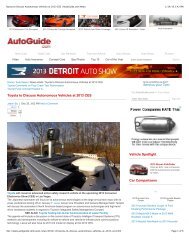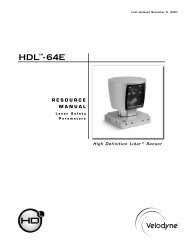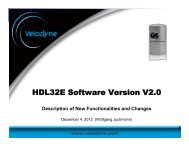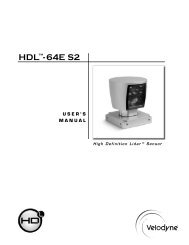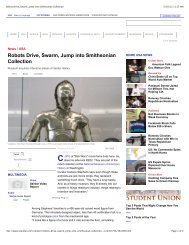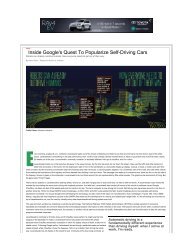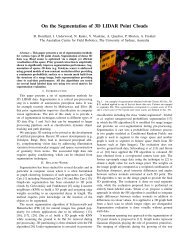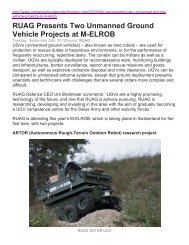How Google's Self-Driving Car Works - IEEE ... - Velodyne Lidar
How Google's Self-Driving Car Works - IEEE ... - Velodyne Lidar
How Google's Self-Driving Car Works - IEEE ... - Velodyne Lidar
- No tags were found...
Create successful ePaper yourself
Turn your PDF publications into a flip-book with our unique Google optimized e-Paper software.
<strong>How</strong> <strong>Google's</strong> <strong>Self</strong>-<strong>Driving</strong> <strong>Car</strong> <strong>Works</strong> - <strong>IEEE</strong> Spectrum<br />
5/30/12 11:21 AM<br />
speeds through <strong>Google's</strong> parking lot, the tires squealing at every turn).<br />
But the project has a serious side. Thrun and his Google colleagues, including co-founders Larry Page and Sergey Brin,<br />
are convinced that smarter vehicles could help make transportation safer and more efficient: <strong>Car</strong>s would drive closer to<br />
each other, making better use of the 80 percent to 90 percent of empty space on roads, and also form speedy convoys<br />
on freeways. They would react faster than humans to avoid accidents, potentially saving thousands of lives. Making<br />
vehicles smarter will require lots of computing power and data, and that's why it makes sense for Google to back the<br />
project, Thrun said in his keynote.<br />
Urmson described another scenario they envision: Vehicles would become a shared resource, a service that people<br />
would use when needed. You'd just tap on your smartphone, and an autonomous car would show up where you are,<br />
ready to drive you anywhere. You'd just sit and relax or do work.<br />
He said they put together a video showing a concept called Caddy Beta that demonstrates the idea of shared vehicles --<br />
in this case, a fleet of autonomous golf carts. He said the golf carts are much simpler than the Priuses in terms of onboard<br />
sensors and computers. In fact, the carts communicate with sensors in the environment to determined their<br />
location and "see" the incoming traffic.<br />
"This is one way we see in the future this technology can . . . actually make transportation better, make it more efficient,"<br />
Urmson said.<br />
Watch:<br />
Thrun and Urmson acknowledged that there are many challenges ahead, including improving the reliability of the cars<br />
and addressing daunting legal and liability issues. But they are optimistic (Nevada recently became the first U.S. state to<br />
make self-driving cars legal.) All the problems of transportation that people see as a huge waste, "we see that as an<br />
opportunity," Thrun said.<br />
PS: Don't miss the first part of the keynote, in which Thrun and Urmson describe their experiences at the DARPA<br />
autonomous vehicle challenges.<br />
Recommend<br />
2151 recommendations. Sign Up to see what your friends<br />
recommend.<br />
http://spectrum.ieee.org/automaton/robotics/artificial-intelligence/how-google-self-driving-car-works<br />
Page 4 of 4






